In May 2018, I had a little mishap on the bike which resulted in what doctors call an “open stellate patella fracture”. In laymen’s terms: my kneecap was smashed, and there was blood. Some 15 months later, in mid-August 2019, I will be on the start line of the 1200km Audax Paris-Brest-Paris. This is what happened in between.
On the tarmac
The pain wasn’t too bad immediately after I hit the tarmac. The problem started when I was trying to stand up.
I failed to do so, as my right leg could not bear weight anymore. I crawled off the road and hugged the post of a pedestrian traffic light on the other side.
I then realised that I could not even stretch the leg anymore, and that I had a really bad swelling above the knee.
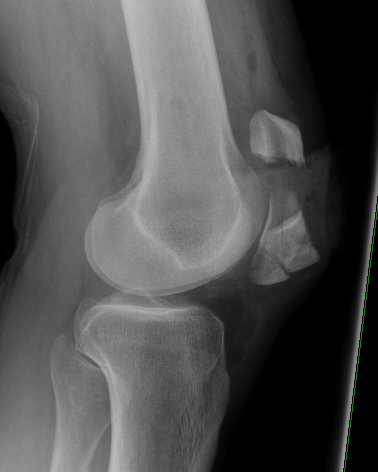
Two young women had seen me flying over the handlebars and thankfully came to my help. They called an ambulance as well as the police and then fetched ice from a nearby restaurant to cool the leg.
They also explained to me what had happened. I had run into a bent black bollard that was leaning into the cycle path about ten centimetres above the ground, hidden in the shade of a traffic light.
All I had noticed was that for one reason or another, my Brompton had disappeared underneath me, making room for the tarmac. Apart from the knee, which landed on the handlebar, I was fine. The bike was alright too.
In the ambulance, before calling my wife, I asked to which hospital they would take me . “Well”, said, the nurse, “ BGU of course. With an injury like this, you really want doctors who know what they are doing.”
At that point, I head no idea about my injury, and I only later learned that BGU stands for Berufsgenossenschaftliche Unfallklinik, a trauma center in Frankfurt run by Germany’s employer’s liability insurance association.
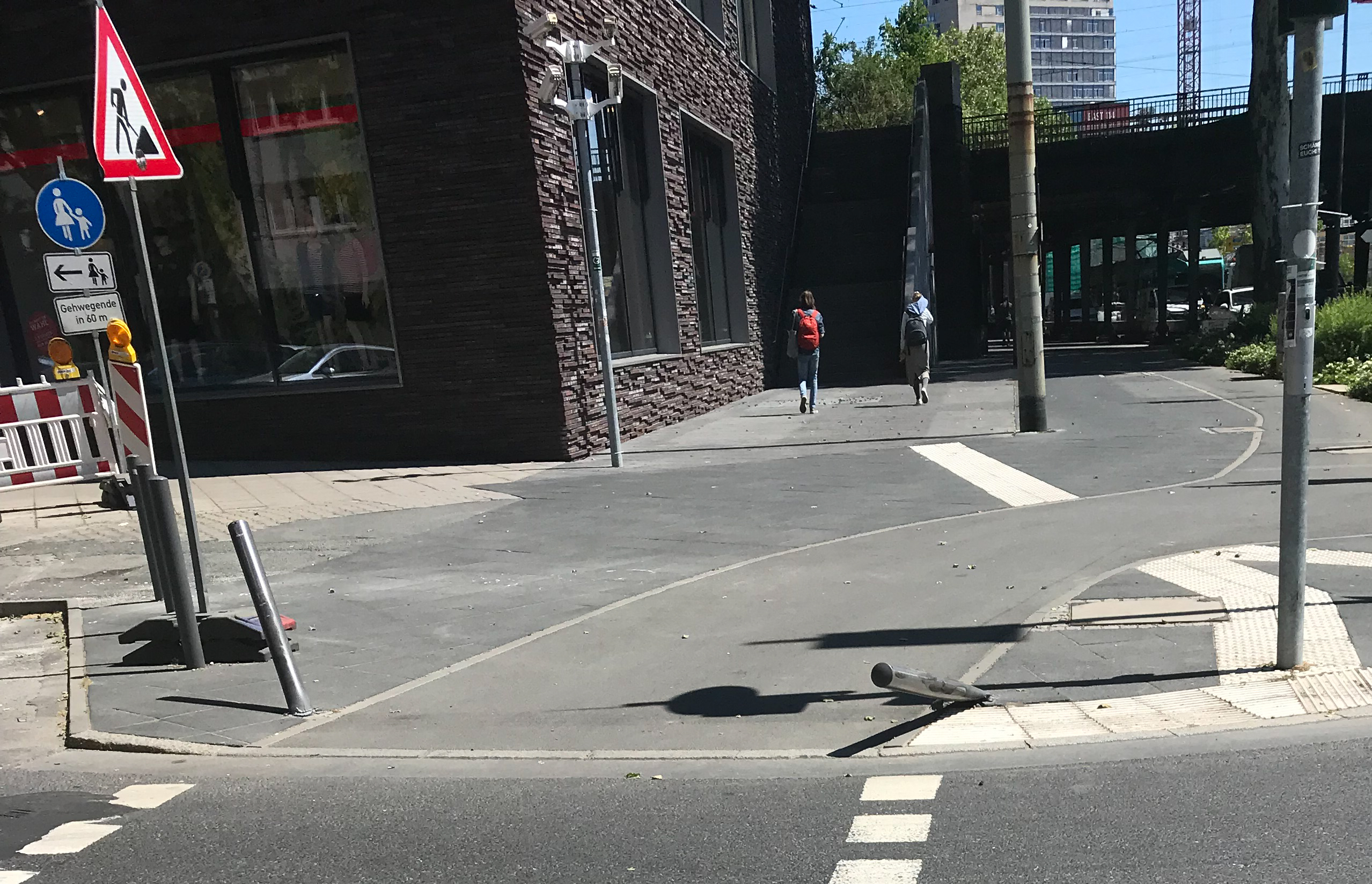
BGU seems to be one of the best trauma centres in the country.
In the ambulance, I did not clock the severity of my injury. The female emergency nurse muttered something along the lines of “the patella is gone”. I had assumed she was talking about the patella tendon, and thought: oh well, this cannot be that bad.
I was a bit puzzled when I later realised that there was quite a lot of blood on the ambulance chair. “Is that all mine?”, I asked the nurse.
Well, yeah.
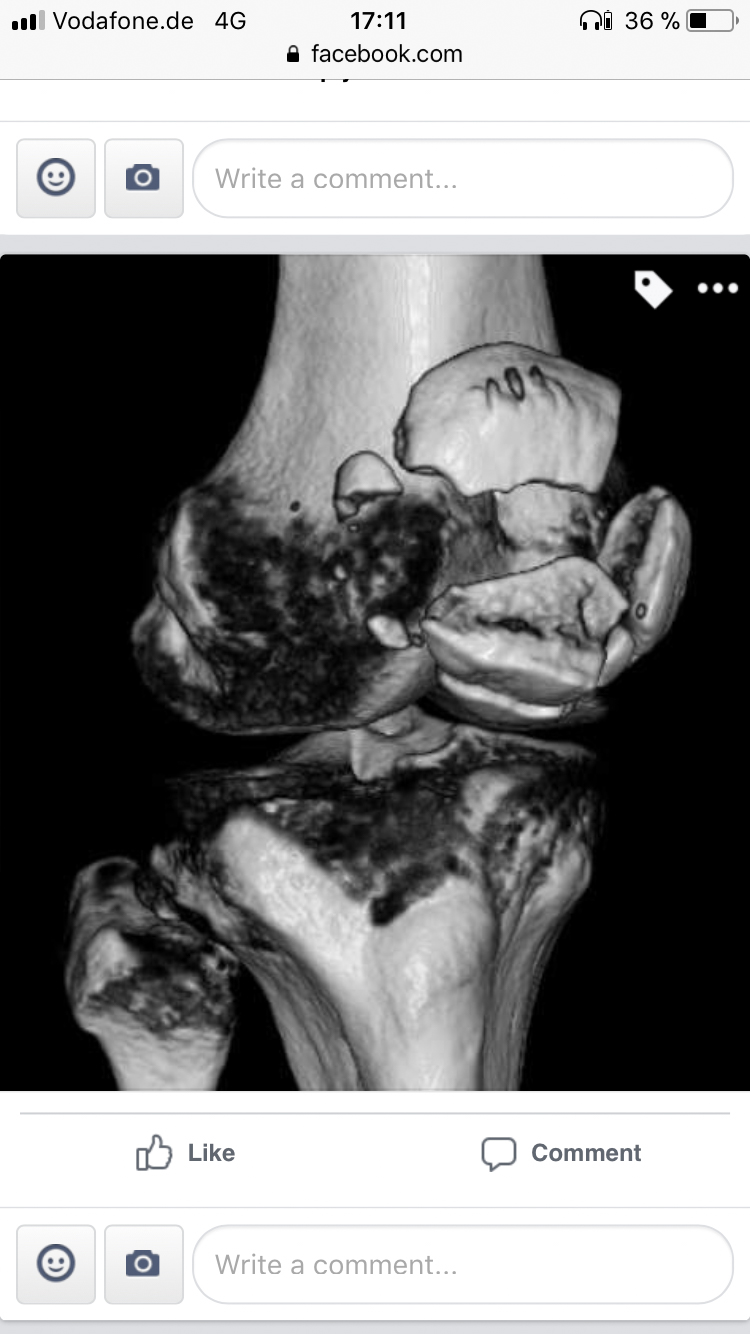
Before leaving me behind at the hospital, one of the nurses gave me a piece of advice that turned out to be valuable over the coming days: “If the pain is getting too bad, make a fuss and ask for some proper painkillers.”
In hospital
At BGU, I learned that my right kneecap – the patella – was literally in tatters. “It’s three parts and quite a lot of crumbs,” said one doctors. Another one compared it to “a bag of nuts”.
Making matters worse, it was an open fracture (hence the blood). This meant there is a very high infection risk, as dirt from the road may have entered the wound. Later, a UK-based friend who is a surgeon himself told me that “with regard to open fractures, the main thing over the first few weeks is to avoid infection”, adding that the rest as almost meaningless.
Open fractures need immediate surgery.
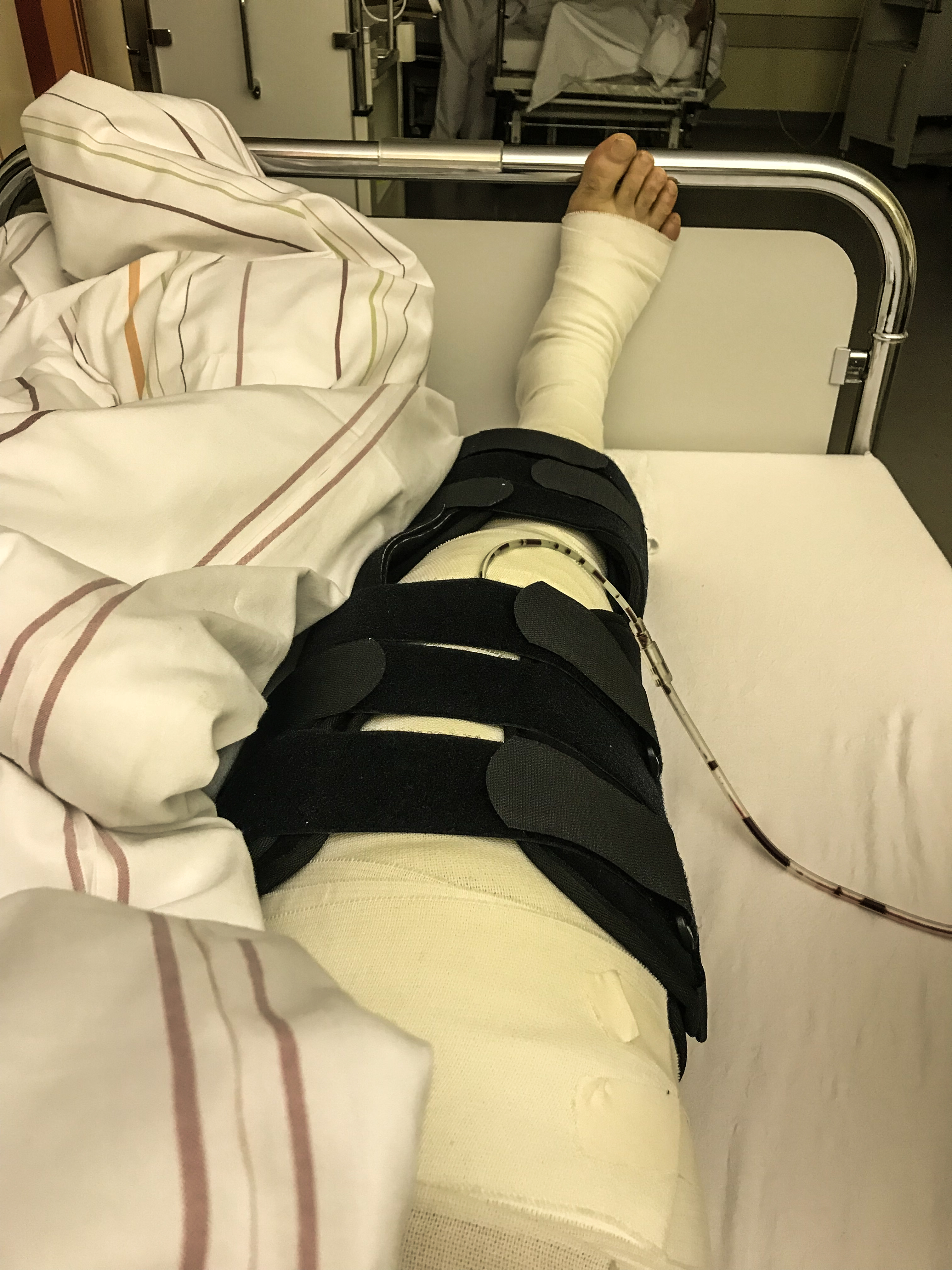
Within three hours, I found myself in the operating theatre, with Professor Doktor Doktor Reinhard Hoffmann – the medical director of BGU – leading the surgery.
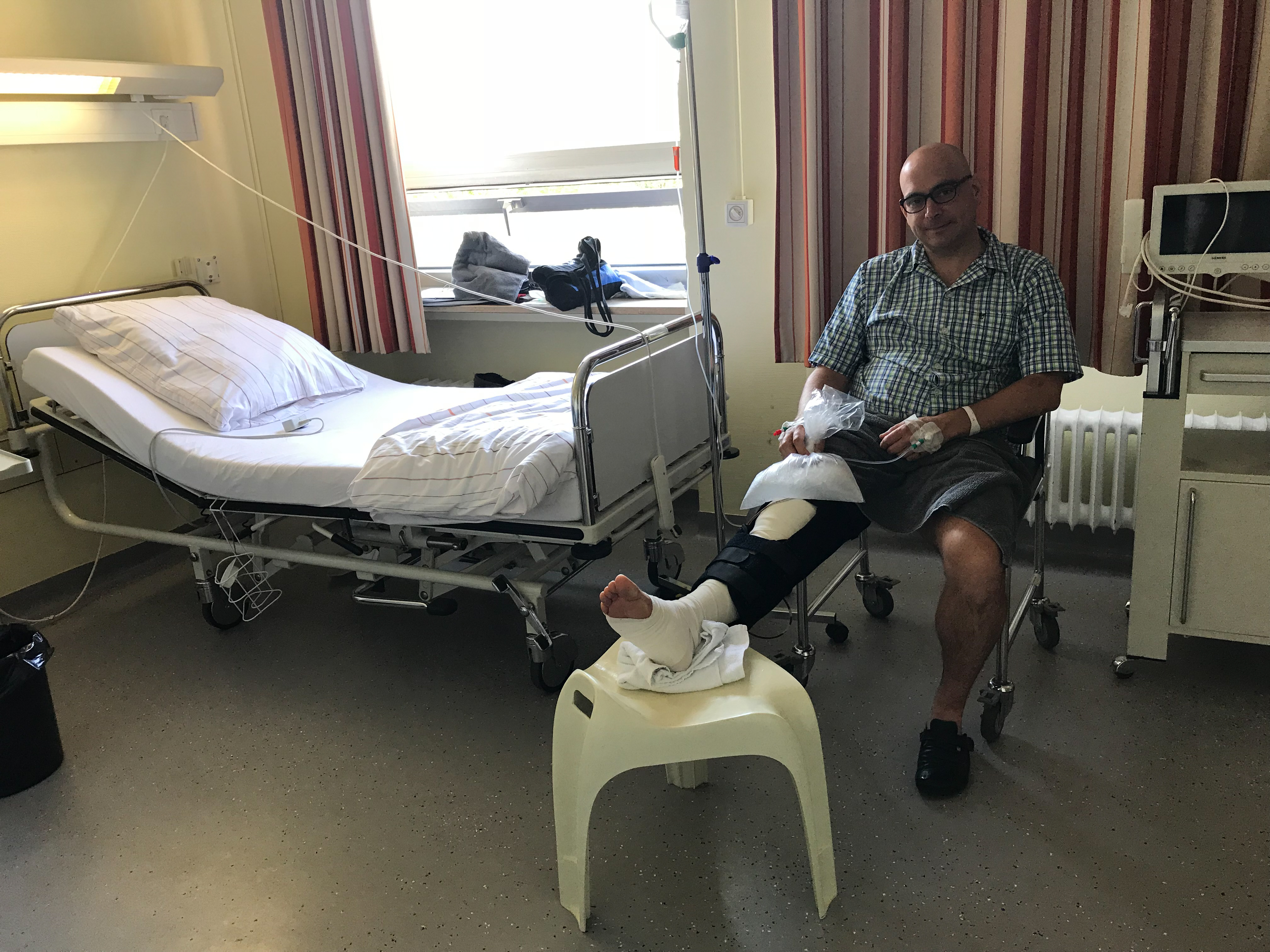
Right after waking up from surgery, somebody told me the surgery had gone really well. On the next day, Herr Professor Doktor Doktor on the ward round told me so himself.
His key concern at the time was about the skin above the knee cap, which was rather knackered. There was a risk that it may not heal properly by itself, given that there were few blood vessels in this area of the body. [This, luckily, proved to be an unnecessary worry, as the skin recovered without any issue.]
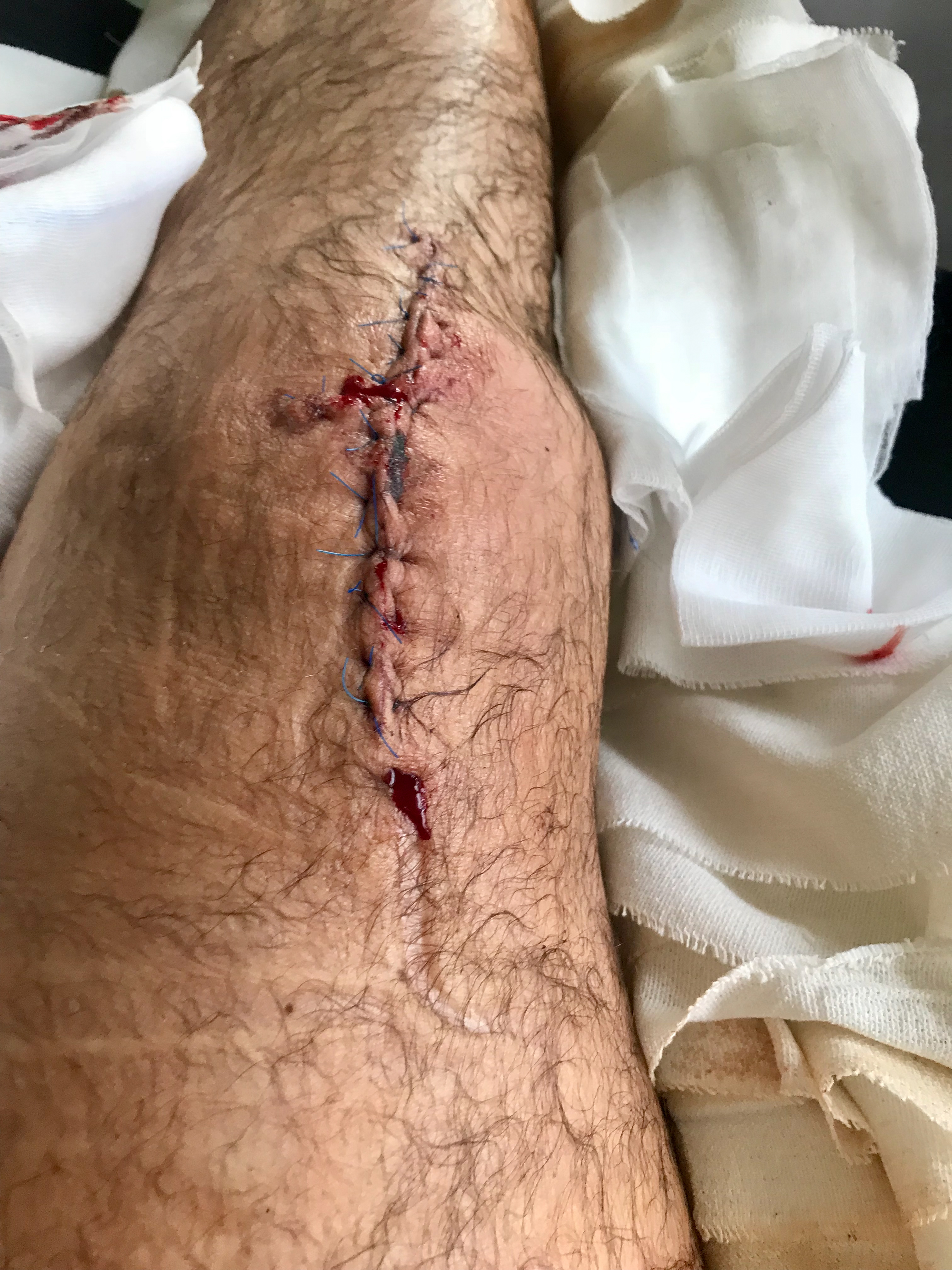
The professor told me that he’s performed the very same surgery on a professional top tier footballer some time back, and that this person has returned to professional football ever since.
“These days, he’s playing in the second division,” the professor added. “Oh that’s great,” I replied. “This then may open up a whole new career opportunity for me.”
I found out later that the footballer was Johannes Flum, who played at Eintracht Frankfurt at the time and now is at FC St. Pauli in Hamburg and whose injury got massive coverage by local media (more on him further down).
After surgery, my leg was totally immobilised for one week. Over the first couple of days, there was a tube sticking in the knee. With regard to pain, these days were by far the worst. I could barely sleep.
I remembered the emergency nurses’ advice on painkiller, and eventually was given a drug called Targin. I had to swallow the pill while a nurse was watching me.
Google told me that Targin is a brand name for the notorious Oxycodon, the morphine derivate at the core of the drug epidemic in the US.
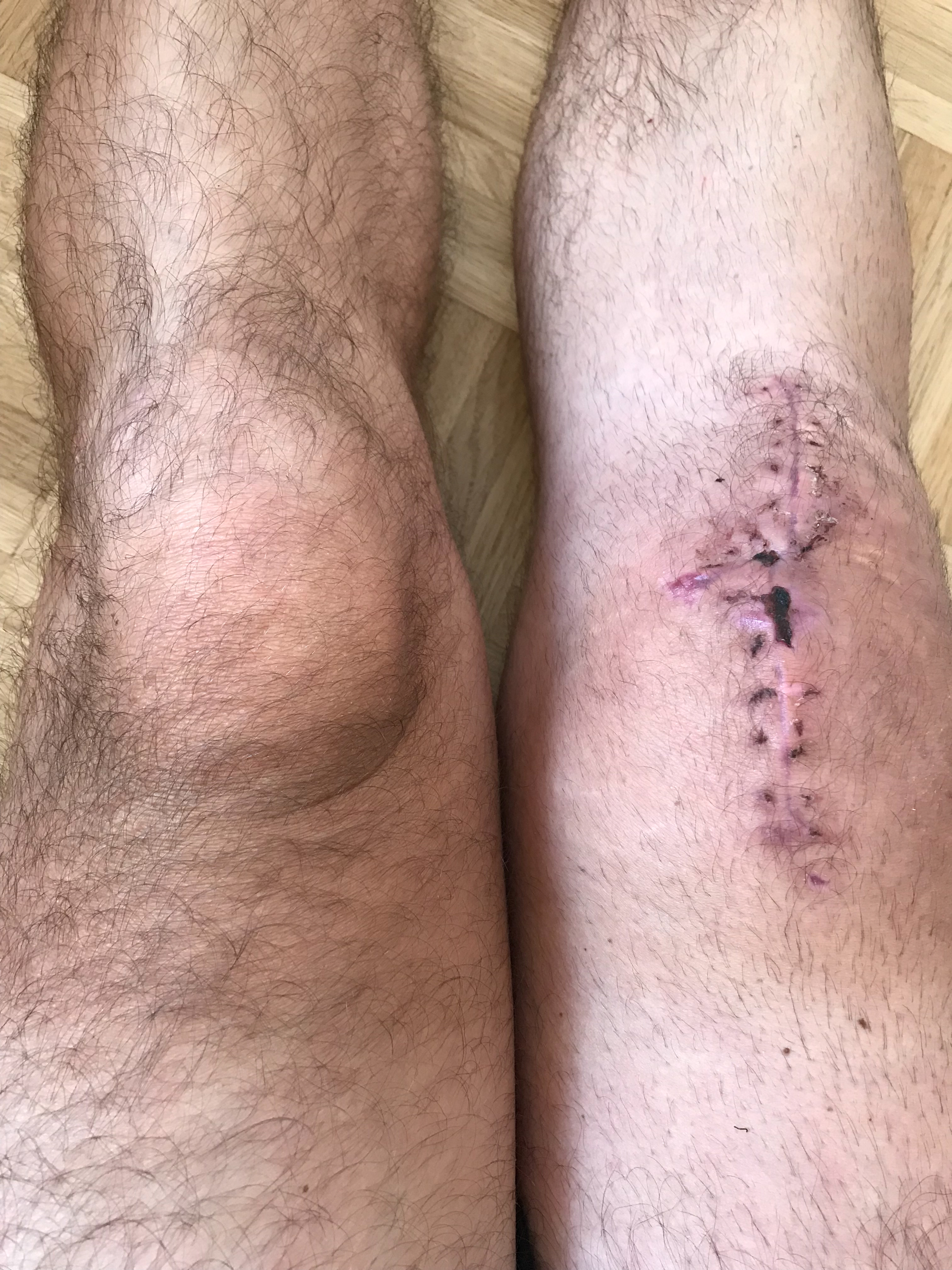
“Oh, hillbilly heroin – nice! ”, a Britisch cycling friend working in law enforcement told me. The Oxy worked fantastically. Not only was the pain gone – I was temporarily feeling really chipper, too. The old adage that the best drugs are available at the doctor is true.
(Another UK friend, who is a cancer specialist, later told me that for them Oxy is merely considers ‘smarties’, as the real pain patients need much more serious stuff….)
After surgery, my leg was totally immobilized for a week. Luckily, I was allowed to put weight on the fully extended leg right away and swiftly needed the crutches just to keep my balance.
On the second day in hospital, I started to walk around and made a foray onto the roof-top terrace of BGU. It was a beautiful sunny morning, and on the horizon I could see the summit of Großer Feldberg, the highest peak in the Taunus mountain range, where I had often ridden up to. I had tears in my eyes.
It still took a few days for my injury’s severity to sink in. A key moment was a phone call with a Cologne-based friend who had buggered tendons in his knee badly in a football injury some years back. He had undergone an odyssey of surgeries and never really got back into football. He rather nonchalantly told me that “your injury is definitely worse than mine”.
I was not feeling too chipper at that moment.
Several friends who had suffered from major injuries in the past had told me that patience was key and that I was in for a mentally as well as physically challenging journey that – in a best case scenario – would last for months. Initially, I somehow wondered what they were talking about, but they were dead right.
At home
I got released from hospital after a week and started physiotherapy right away, having sessions two to three times a week with Christiane Kelber in Frankfurt Sachsenhausen, an outstanding physiotherapist. She doesn’t just have more than four decades of experience but also a fantastic sense of humour. We laughed a lot.
A week after surgery, I was allowed to move my knee by 30 degrees. A couple of weeks later that was changed to 60 degrees, which still isn’t a lot.
The BGU physiotherapist mentioned the option of me getting a continuous passive motion device at home. That was one of the best things which happened to me after surgery.
The device helped a lot against the swelling, reduced the pain and to work on the leg’s mobility. I was told to use it four times a day, for at least 30 minutes each. I often spent twice the time in it , if not more.
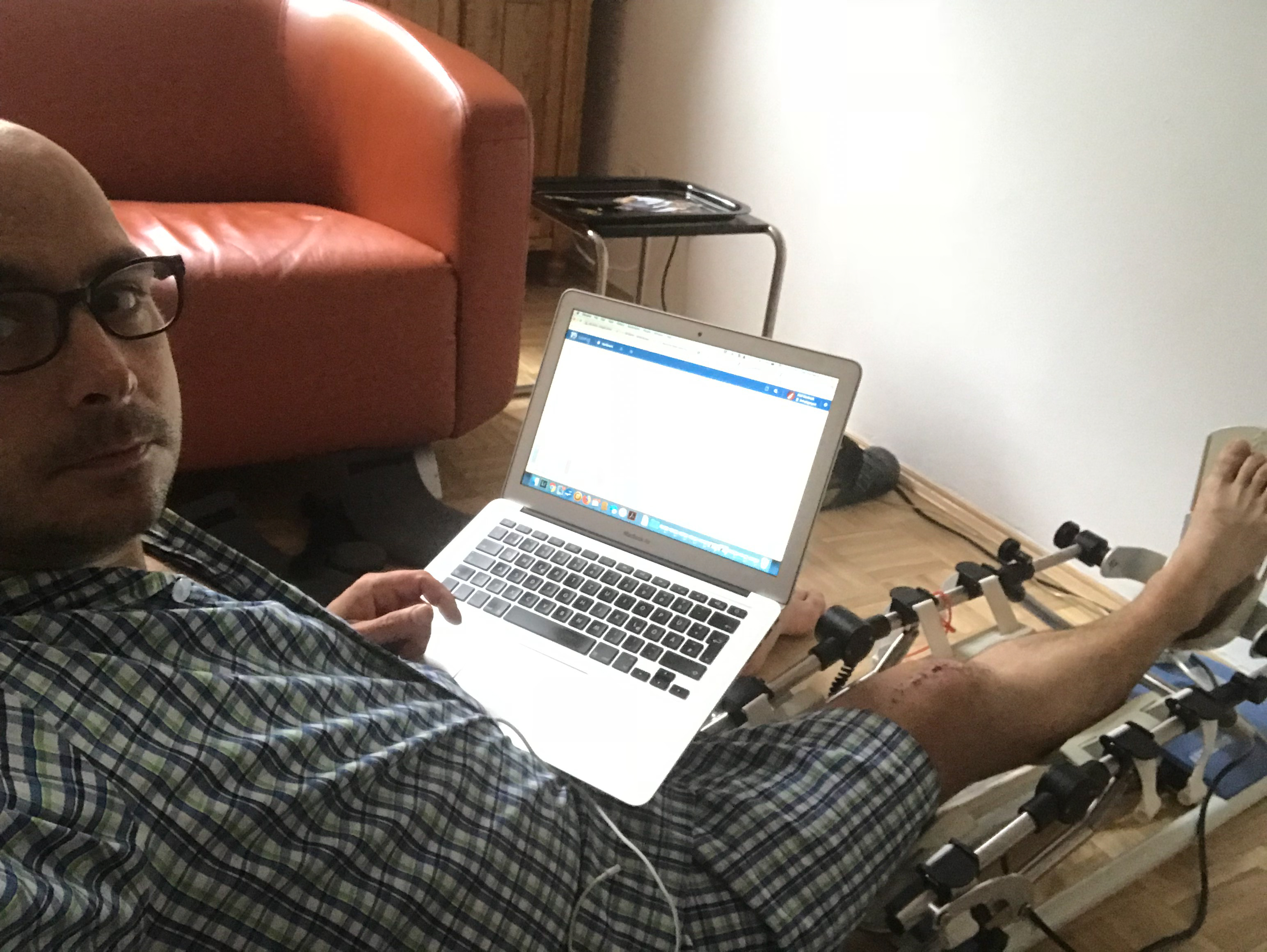
After six weeks, the brace came off and – in theory – I was allowed to use the leg’s full range of motion.
I had looked forward to that moment, assuming I would be back to normal soon. What a silly thought! Even without the brace, I barely managed to bend the leg by 60 degrees. Progress with regard to the range of motion was really slow.
That phase was one of the most frustrating periods of the recovery.
My employer had been more than fantastic in supporting me. I had only joined some eight months before the accident, and was calling in sick for a long time. Not great.
After six weeks, I was more than keen on properly returning to the office. But after a couple of days, I had to face the fact that this would just not work.
The mere walk to the subway station, and from the station to the office, was a slog. And the leg really didn’t fancy sitting in an office chair. It still needed to be cooled, too, and was missing the time spent in the CPM. Hence I went back on sick leave for another weeks or so.
At least, I was slowly getting back on the bike. On an online bike forum, someone who had fractured his hip had told me about a “pedal pendulum” – a special device you put on the bike’s crank to adjust it to the reduced range of motion.
On a normal bike, you need to be able to bend your leg by at least 110 degrees. The pedal pendulum, which also shortened the crank, makes it possible to start with 70 degrees.
I bought the “Pedalpendel Pro” (which was even reimbursed by the Berufsgenossenschaft), called “Range-of-motion pedal” by its Dutch manufacturer “Fietsen op Maat”.
I also ordered a smart trainer for a bike. In hospital, doctors told me it would take three months until I was able to cycle again.
Thanks to the ROM pedal, I was able to cut that time in half. On June 22 – six weeks after my surgery – I did my first session on the stationary bike. I lasted for 19 minutes and was really knackered afterwards.
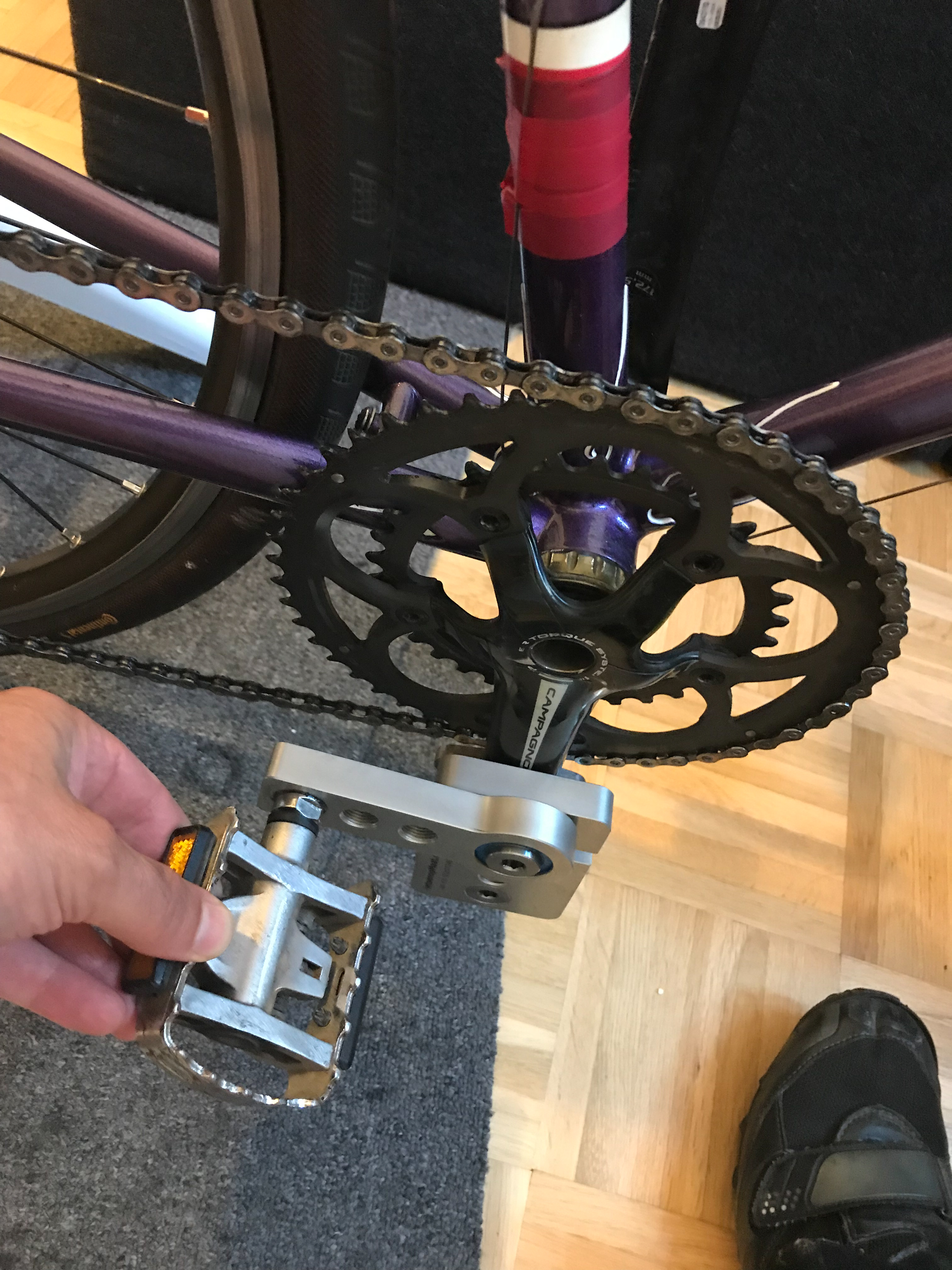
I had ridden 459km in a moving time of 20:35 hours a couple of days ahead of my crash. Compared to that, my stint on the roller was not even a joke. It was still a very significant moment for me, and I felt very happy. It was a start.
I increased my range of motion significantly over the coming weeks. The knee liked pedalling even more than being in the CPM. After about three weeks, I did not need the ROM pedal anymore.

That was when dared to try an outdoor bike for the first time. The first few meters were even better than Targin. I felt like a little boy who had just learned to ride a bike. The wind blowing around my head, the sense of weightlessness, the movement – pure magic.
In early August, some four months after the surgery, I started an outpatient rehabilitation program at Proreha Frankfurt, a physio center that takes care of the Frankfurt professional football team and the regional Olympic athletes.
Three days a week, two hours per day, I did focused weight training and other exercises under close supervision from an expert (The German name for the scheme is EAP or “erweiterte angewandte Physiotherapie”). It did pay off massively.
In late August, I did my first DIY-200km Audax, some 15 weeks after the surgery. I had chosen a very flat route down the Rhine and back, and it went surprisingly well. Interestingly enough, the leg – like its owner – liked cycling much more than sitting in an office chair.
That was more than encouraging.
Medical details
What I only understand over time was how lucky I had been with regards to my injury and the medical treatment I received.
The relatively good thing about the injury was that “only” the knee cap was knackered. All tendons and nerves were undamaged. Bones, if treated properly, heal much better than tendons.
Patella fractures are a relatively rare injury, only affecting about 1 per cent of all fractures.
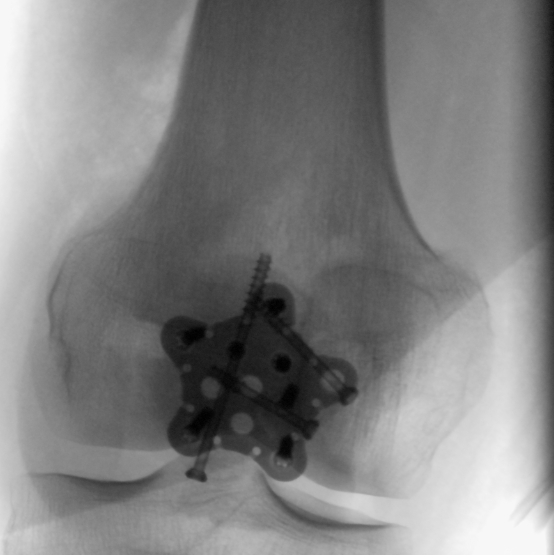
Part of my luck was that in December 2015, Eintracht Frankfurter midfielder Johannes Flum had been unlucky. He suffered the same injury in a training accident and got treated by the same “top surgeon” (German tabloid Bild) Reinhard Hoffman than me.

Ironically enough, as I learned from the old newspaper reports, Mr Flum had been flown to the hospital by helicopter. However, he still had to wait for some 24 hours until he got surgery. I arrived in a mundane ambulance but was treated within some three hours. (I earned this privilege by the open fracture, which needs immediate treatment to mitigate the infection risk.)
Both Mr Flum and I benefitted massively from a new operation technique devised by Munich-based medical company Arthrex: the so called “Patella Suture Plate”, which yields much better results than the traditional treatment involving tension band wiring.
The x-ray actually reveals a real piece of art – a total number of 10 (sic!) bolts plus the Arthrex’s “star plate” are holding the bits and bobs of my kneecap togehter.. These days, I’m largely pain free, have some 95 per cent of mobility back, and the knee is actually starting to look like one. It still feels a bit strange at times, but who cares about that? It does the job.
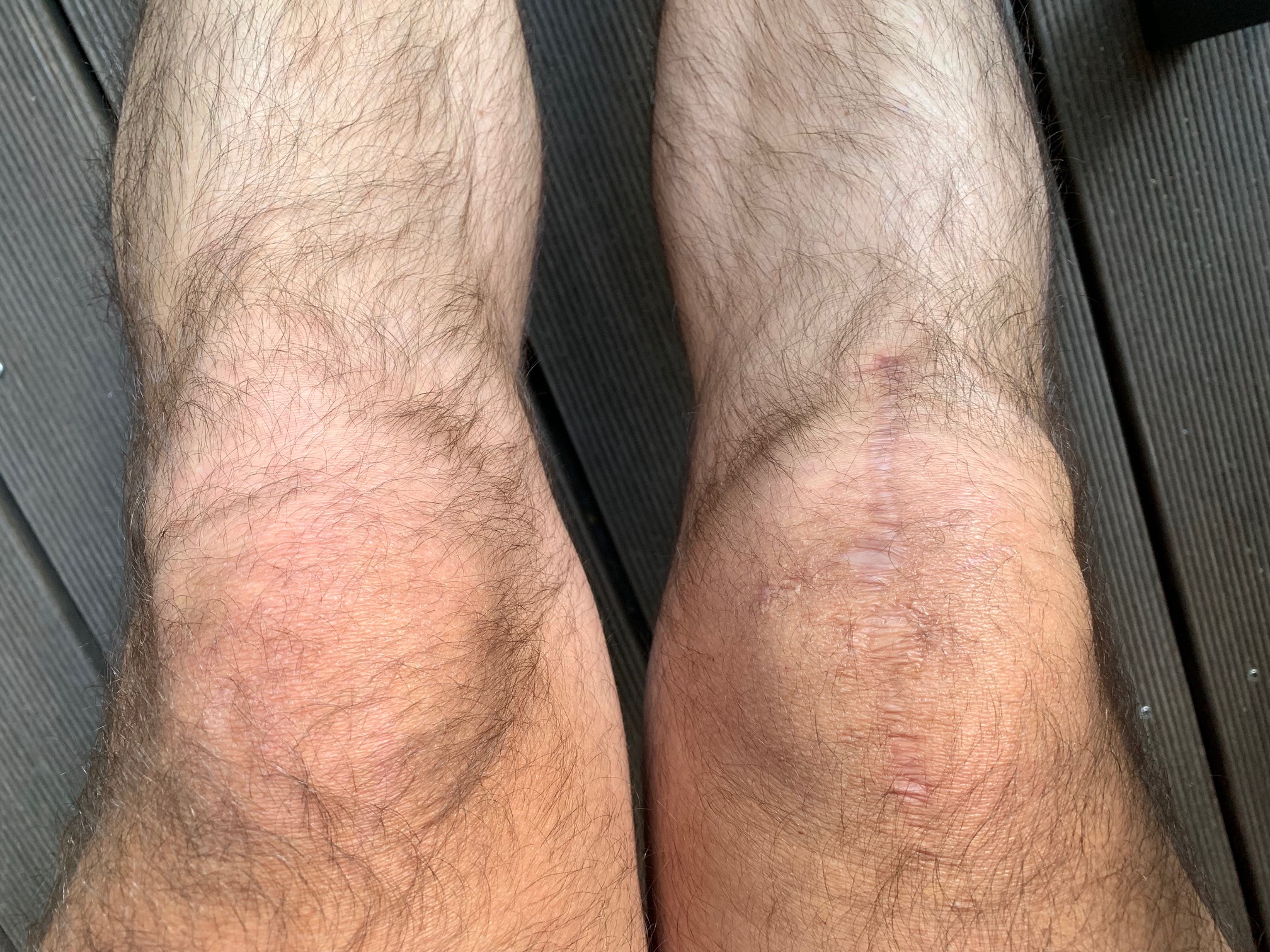
For now, in late September, I have another meeting scheduled with the Professor, who is going to remove the titanium collection from my knee again.
I hope I can keep the parts.
Serious cycling
After some three or four months, my range of motion was almost back to normal. Since riding it in 2015, my plan for 2019 had been to to the 1230km bike ride from Paris to Brest and back in the summer.
That required a successful qualification – doing a a series of a 200km, 300km, 400km and 600km rides between March and May – in 2019.
It was quite a stretch, as I was still unfit and the weather conditions on my entire SR series were rather challenging. On the 400km ride in mid-April, we had snow.

Time and again, I was frustrated, and on the second day of my 600 qualifier – Windsor-Chester-Windsor in good old England – I decided to back out of PBP because of a lack in fitness. [Luckily, the golden rule about Audaxing applied: Any decision on future rides taken on a ride are not valid.]
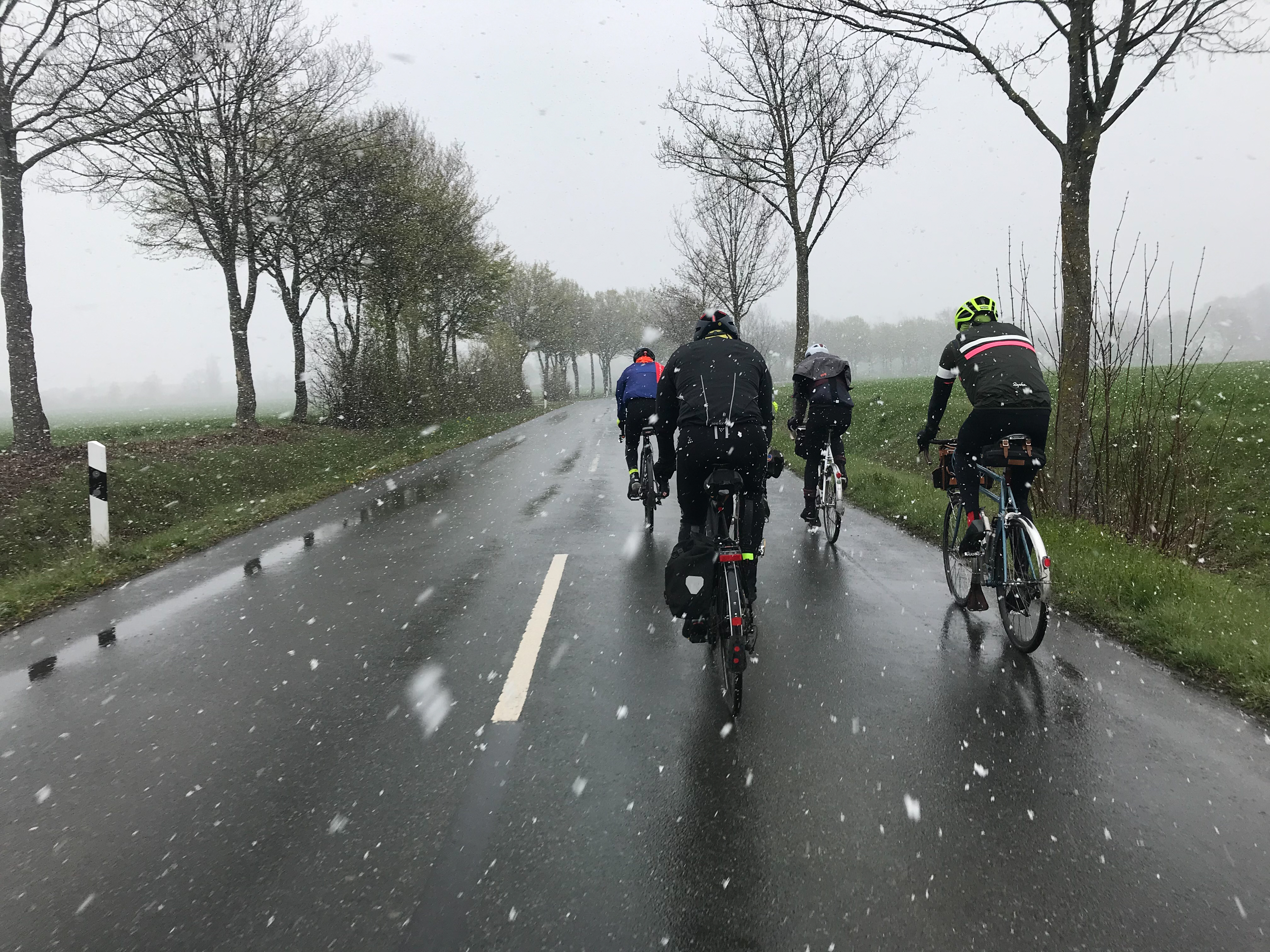
Going uphill proved to be the biggest problem, as the strength in the leg was just gone.
After Windsor-Chester-Windsor, my knee possessed the extravagance of starting to hurt seriously again, and to swell a bit. I went to see my doctor dealing with the after care, Markus C. Heine at Orthopädischen Zentrums Frankfurt Süd.
I told him about my 600km ride over the previous weekend as well as my plan to ride twice the distance in four days in August.

I was expecting him to get me sectioned immediately. However, Dr Heine just told me that he thinks the worst that could happen on an even longer ride was that the knee swells so significantly that I might be unable to carry on.
As I was planning to ride in France, rather than the Namibian desert, there was no reason to be overly concerned. “I mean, you won’t starve to death or die of dehydration, will you?,” said the doctor.
I asked him if there was a risk to structurally damage the knee by overusing it, and he said “no, you did the damage a year ago”.

He prescribed me an active knee support called Genutrain by German manufacturer Bauernfeind. It seems to help.
Only after I completed qualification, rides slowly but surely became gradually easier.
But I’m in good company in this respect as well. It took about a year until Mr Flum was back in professional training, and it was a frustrating journey for him, I was told. I am sure he worked much harder on his recovery than I did.
By the end of July, I had ridden close to 7800km year-to-date, slightly less than ahead of my first PBP in 2015 but a bit more than ahead of LEL 2017 (my Strava data these days does not include commutes, so the milage shown there is a tad lower).

More importantly, courtesy of the more hilly countryside around Frankfurt, I had done almost 50 per cent more climbing as in 2015.
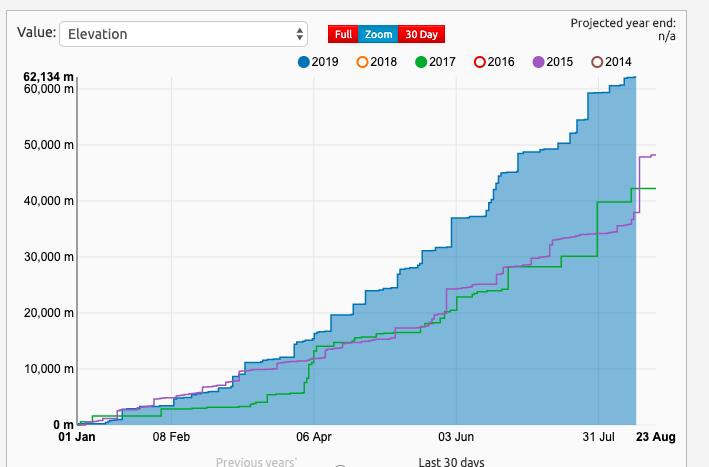
The final litmus test was a hilly unofficial 400km Audax with an evening start in late July, covering almost half the PBP climbing in one third of the distance and with a moving average of 20.4 kph. Proper cyclists will laugh about the speed or the lack thereof, but I was rather pleased – in particular as the day was boiling hot.
I am still awaiting PBP with the same if nor more trepidation as in 2015.
Wish me luck.
Post scriptum: Gratitude
I have to admit that I tend to be a cynic, expecting that things normally go pear-shaped – in particular when public service institutions like the police or the medical service are involved. There are just to many horror stories of people getting wrong treatment.
Oddly enough, however, my patella saga from A to Z worked out perfectly.
From the moment I hit the tarmac, I have been incredibly lucky.
Starting with the two young women witnessing the crash and helping me immediately afterwards, the police crew who dealt with the situation highly professionally and were very friendly. The ambulance team sterling, the doctors and nurses in hospital and in after-treatment, the physios….
Even the legal and financial side of things worked out. My lawyer Petra Kyaw did an excellent job.
Luckily, the lorry driver who had run into the bollard a few minutes earlier and reported himself to police. His insurance which covered my bills swiftly and even paid out a decent compensation.
Germany’s statuary accident insurance who covered all the bills as it was a work accident, my colleagues and bosses in Frankfurt and London who, at every stage, were extremely supportive.
Months after the accident, it occurred to me that the whole episode is an example of what a fantastic society we life in.
You can find yourself completely helpless in the middle of the road, with a potentially life-changing injury. What happens next is that a clockwork of well-trained people gets in motion, you receive the best medical care possible without having to pay a penny. And 15 month on, you can be on the start line of PBP.
Sometimes it takes a really bad mishap to realise how lucky you are.
Post scriptum II: A word on bollards
My only niggle are the bollards of Frankfurt. The German highway code stipulates that bollards have to be coloured red and white to make sure they are visible.
With regard to bollards put on cycle path, the city of Frankfurt like many others is ignoring this, and uses grey bollards instead.

Surely, they look much nicer, but they pose a real danger to cyclists as it is much easier to overlook them.
In my mind, the city is violating its duty of care, and should be taken to task for this. However, my lawyer advised me that any legal action looks like a lost cause right from the onset.
Just for the fun of it, I nonetheless filed a criminal complaint against the city’s road planners because of the non-compliant bollard, accusing them of dangerously interfering with road traffic, which is a criminal offence under German law. Predictably, this went nowhere as the criminal prosecution office rejected to investigate the case.
Update:
In August 2019, I successfully finished the 1200km Paris-Brest-Paris Audax and was even three hours quicker than four years earlier. Afterwards, I went on a three-weeks cycling holiday in France, riding another 1500km, both without having any knee issues.
Overall in 2019, I cycled 13.045km – my the second highest milage ever.

A week after the bike holiday, I had my second knee surgery where the the 10 bolts and the titanium cap were removed. Luckily, everything went fine, and I was back on the bike after two weeks.
While the knee is still a bit swollen and sometimes a bit stiff three months after surgery, mobility is almost entirely back to normal. Interestingly enough, the stiffness is worse during times when I’m not cycling a lot.
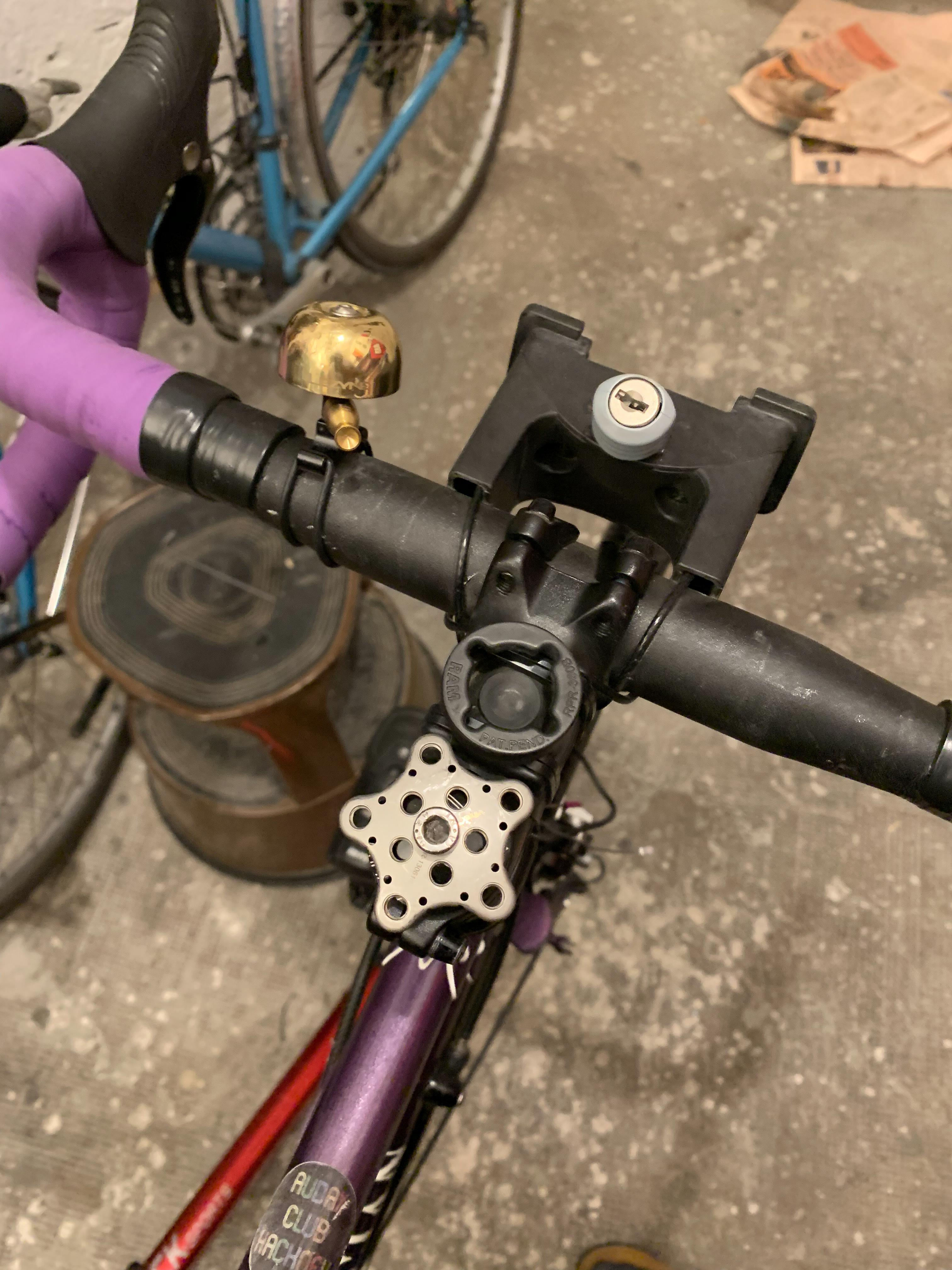
Update 2
A shorter account of my recovery in German can be found in “BGU inform”, the biannual magazine of BG Unfallklinik Frankfurt on pages 11 and 12.
Update 3 – a word on the arthritis risk
Even before the emergency surgery on May 8, 2018, one of the doctors in warned me that I’ll be facing a significantly higher risk of arthritis due to the injury.
After the metal-removal surgery in September 2019, I noticed that the knee was starting to make a crunching sound in certain situations – for instance, when I walk down steep stairs. Also, even several months after the second surgery, the knee was still stiffer and twitchy.
An MRI scan in early 2020 confirmed that parts of the cartilage on the patella’s rear are significantly damaged (stage 3-4, with stage 4 damage equivalent to full-scale arthritis). According to my doctor, a knee cartilage transplant may be an option at some point in the future.
However, the advise for now is to wait and see how the situation will develop over the next couple of years or so.
Several other cyclists suffering from knee arthritis told me that they are able to keep the pain at bay as long as they make sure they train enough to make sure their leg muscles remain strong.
I’m not overly keen to have yet another surgery. What turns me off in particular is the fact that the knee needs at least three months of rest after a cartilage transplant – that means an even longer recovery than after the initial surgery…
On the other hand, addressing the arthritis early on may help to contain long-term damage. It’s a tough decision to take…

Pingback: Beyond the jitters and through the bulge – my PBP 2019 – Cycling Intelligence
I have just suffered a closed fracture of my right patellar while falling on my right knee while turning while going downhill at about 30km/h and the kneecap just caved in and was visibly abnormal in shape. I couldn’t even get off the ground, unable to straighten my leg. Luckily a passing motorist stopped and helped to reassure me and helped me to call for an ambulance.
The lifting off the ground into the ambulance was most excruciatingly painful despite it being immobilised beforehand.
I thank my luck for the motorist who stopped and helped and for the quick response of the emergency services. I had the surgery done 24 hrs after my admission and I asked the radiographers whether I had really screwed up my knee. He said: at least it’s only cracked in half. I didn’t know if it was a good thing or not as it really felt painful.
The morning after the surgery the physiotherapist came by and asked me to do 30 straight leg raises. It was painful but I managed to do quite well and was allowed to do weight bearing walking for a short distance.
I cycle for a living ( I am a bike courier) and I also love cycling. I was very concerned if I was able to be able to get back on the bike again. The other bad point is the loss of income for a few months while I recover.
Your sharing of your experience was inspiring as you have suffered a much more severe fracture and was still able to bounce back with courage. The only change I might add in the future would be a good pair of knee protectors. Thank you so much and ride on!
Hey Alex,
oh dear! I can – literallly – feel your pain! I am sure you’ll have a speedy recovery, but the key thing really is to remain patient. At times, this can be rather difficult but you’ll be fine eventually.
Thanks a lot for your kind comment – glad this post proved helpful. Keep your spirits up and see you down the road!
Cheers
Oalf
Lieber Olaf,
vielen Dank für das Teilen deines Genesungsweges.
Mir ist Ende April diesen Jahres ähnliches passiert. Offene Trümmerfraktur der Patella – 16 Fragmente und Sehnenabrisse.
Ich habe mich intensiv auf den Ironman vorbereitet mit der Hoffnung mich dieses Jahr für die WM zu qualifizieren, als der Sturz passierte.
Nach anfänglicher Phase der Konzentration auf die Schmerzreduktion, habe ich mich nach der Krankenhausentlassung auf die Suche nach einer erfolgreichen Genesungsgeschichte begeben. Insgesamt findet man zu Trümmerfrakturen leider nicht viele positive Beispiele vollständiger Genesung.
Ich bin daher äußerst froh und dankbar auf deinen Blogeintrag gestoßen zu sein. Die ersten Erfahrungen und Bilder spiegeln auch meine Erlebnisse wider.
Dein Bericht gibt mir Hoffnung und Zuversicht zumindest zwei der drei Sportarten in Zukunft mit Freude und Qualität ausführen zu können.
Liebe Grüße und nochmals vielen Dank
Martin
Lieber Martin,
oh je, was machst du für Sachen? Wünsche eine gute Genesung, und viel Geduld!
Beste Grüße
Olaf
PS habe dir eine Email geschrieben
I didn’t got such a professional treatment here in Munich. I just had a simple transverse fracture but I got misdiagnosed two times. They said my knee was fine, even though I could feel the sharp edge on my kneecap and couldn’t walk. After 10 days I got the surgery and 3 hours of physical therapy. 6 Weeks have passed, still recovering… 😦
I didn’t got such a professional treatment here in Munich. I just had a simple transverse fracture but I got misdiagnosed two times. They said my knee was fine, even though I could feel the sharp edge on my kneecap and couldn’t walk. After 10 days I got the surgery and 3 hours of physical therapy. 6 Weeks have passed, still recovering… 😦
Oh dear. Sorry to hear this! Get well soon. Make sure to get ample physiotherapie and ideally an electric splint (“Motorschiene”) to mobilise the knee.
How are you now recovery wise 3year later?
Thankfully, my surgeon re-attached my patella with no visible step. And I got more physiotherapy prescribed, but in reality, you have to do your own exercises at home everyday day. I did lots of workouts and after 2,5 years, I managed to do single leg squats again. I still have pain, going down stairs hurts, especially if I did to many workouts bevor. Overall my knee is in a pretty good condition but It limits my sportive ambitions a bit.
Glad to hear you’re bouncing back quite fine Olaf. Personally it’s been not too great progress but I am seeing improvements incrementally. Four to six months after surgery on Feb 2020, any excessive exertion or strain on the kneecap will cause the kneecap to totally swell up, which totally takes you out of your ride or even walking normally. I took easy rides gradually build up lost strength. I also decided of remove the internal fixation rods and wires on March 2021. After that, it was another 2 months of taking it easy to allow healing. I am back on my courier job now doing around 60km per day in a hilly area. There is noticeable loss of power while doing very steep climbs compared to preinjury but on the flip side the knee swelling has not reared it’s ugly head again. There is still sometimes what feels like moderate patella pain on the injured knee after a day’s work but I hope it’s not a sign of early arthritis. Overall the recovery process is a marathon in itself and there and good days and bad days. Patience and listening to your knee is very important. Push it too hard and it’s likely to be counterproductive. Personally I don’t expect to be ever back to normal again but I am grateful I can at least cycle again. I have seen one-legged cyclists on YouTube and they have reminded me to keep my chin up when things are getting tough!
Hi Alex,
good to hear from you. Actually, give yourself more time! I guess the swelling was down to the metal wires in your knee. The recovery after the 2nd surgerey, when the metal was removed, took much longer than I expected. I had the surgery in Oct 2019, and even in the summer of 2020 I had to wear the knee bandage when cycling hard as the leg was inconvenient (not really painful) after a long day of cycling. That’s gone now but it took almost a year after the 2nd surgery….
Keep up your spirits!
Cheers
Olaf
Hello Olaf,
Thank you for taking the time to share your story. I too fractured my right patella and I am 8 weeks post-op. It was a transverse fracture and displaced. Pins and k-wires were placed to bring the pieces together. My surgeon has stated that as there is not much skin on my knee, the wires will be scheduled to come out in November. I am not likely to recover without being bothered by the wires.
At 5 weeks the surgeon declared the bone healed by x-ray examination. I was thrilled to hear that I was ahead of his expectations. I did not know what was ahead…..intensive PT exercises….on the ‘range of motion’ path. It takes most of my day with rest, walks, icing and elevating, massaging my knee, and a few 5-10 minute spin bike sessions. I also do a little foam rolling on the unaffected parts of my leg to relieve tension.
I am able to make a full revolution on my spin bike at a high seat setting. I diligently do PT exercises throughout the entire day, however, my knee stiffens right up shortly after and between all the exercises, making walking still ‘clunky’. I was given a walking stick or I can use one crutch and I can move short distances without assistance, My insurance is limited and a CPM machine was never mentioned.
I am wondering during what weeks did you. most use the ‘electric splint’? Also, how long did it take you to recover full ROM? Not recovering full ROM is my biggest fear as someone who loves YOGA, cycling, sailing, hiking and gardening and basically lives a very active lifestyle.
Perhaps I should consider renting a CPM machine?
How is your knee five years on from your accident? Are you still challenged by the potential of arthritis?
Of all the things in life I have enjoyed, this sure is a bummer to be experiencing. I fell, in my own driveway, when I was walking my dog :(, Tripped in a pot hole, lost footing with my left foot, and landed solid on my right knee cap on the asphalt.
Again, thanks for the time you spent sharing your story. I would love to hear an update. And if you have time to answer, I would be most grateful.
Your cycling trips look epic, thanks for your encouraging posts.
Lanora P
Hi Olaf. How is your cartilage / arthritis now? Did you end up having another operation? I’m facing similar issues. What was your rom before plate removal and after?